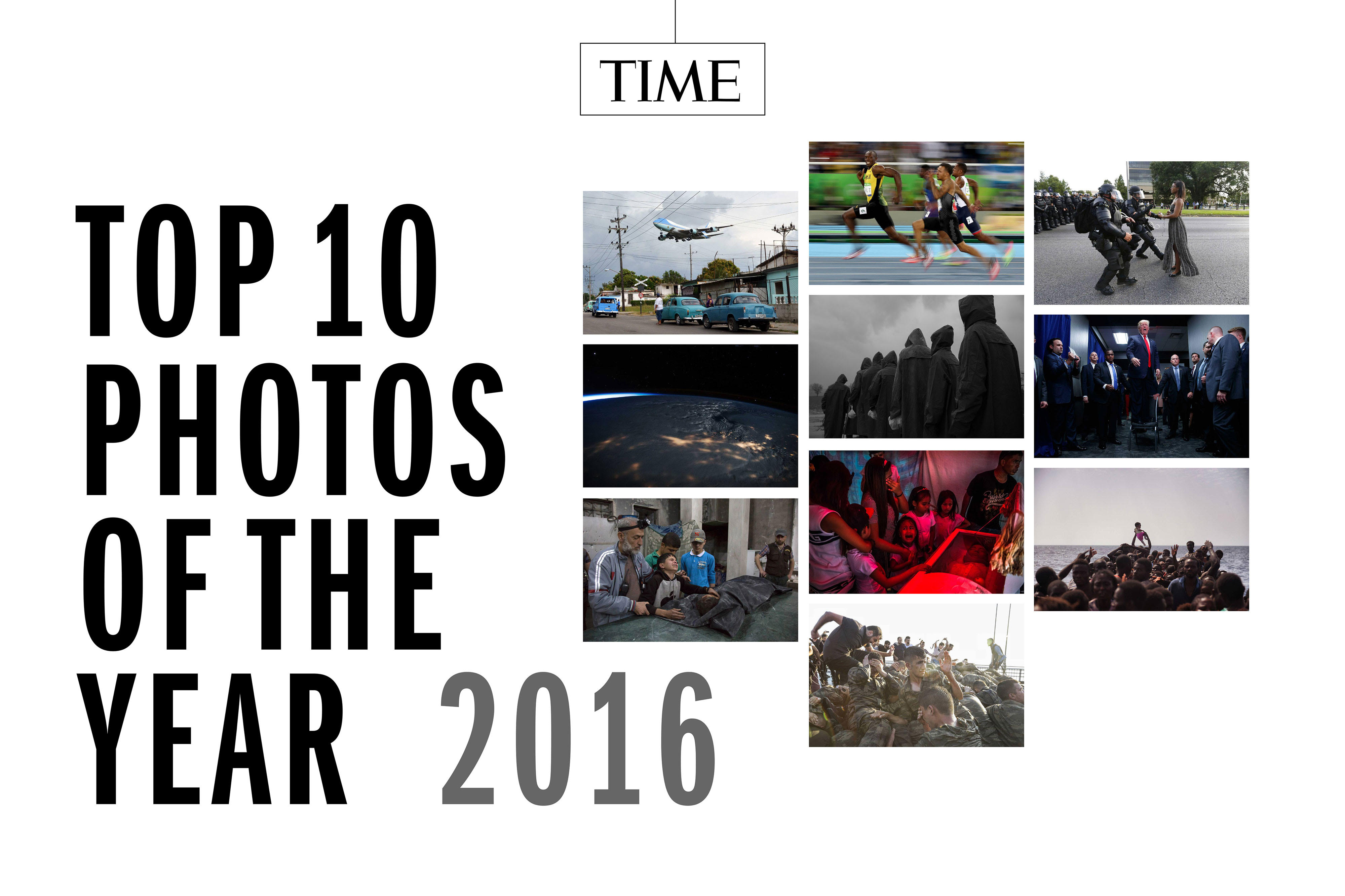2016 has been a year like no other. From the U.S. campaign trail to the refugee crisis and the Olympics, the news has kept photographers on their toes, pushing new boundaries and expanding their vision. We were blown away by the exquisite work we have seen day in and day out. They are a relentless group.
Over the last few months we have been poring over thousands of photographs that provide a snapshot of the year in news and culture. There were so many runners up to this year’s Top 10 photos but these, we feel, are the most striking and lasting. We spoke to each of the photographers about the picture they made; their words provide the captions that accompany their photos in this unranked gallery.
Last month, we published 100 Most Influential Photos of All Time, curated by TIME’s photo editors. The hardest part of the selection was choosing pictures from very recent history, because it’s usually time that dictates how influence can be quantified. Is there a picture in this Top 10 here that can be number 101? We invite your debate and discussion on TIME LightBox’s Twitter and Facebook. — Kira Pollack, TIME’s Director of Photography and Visual Enterprise.
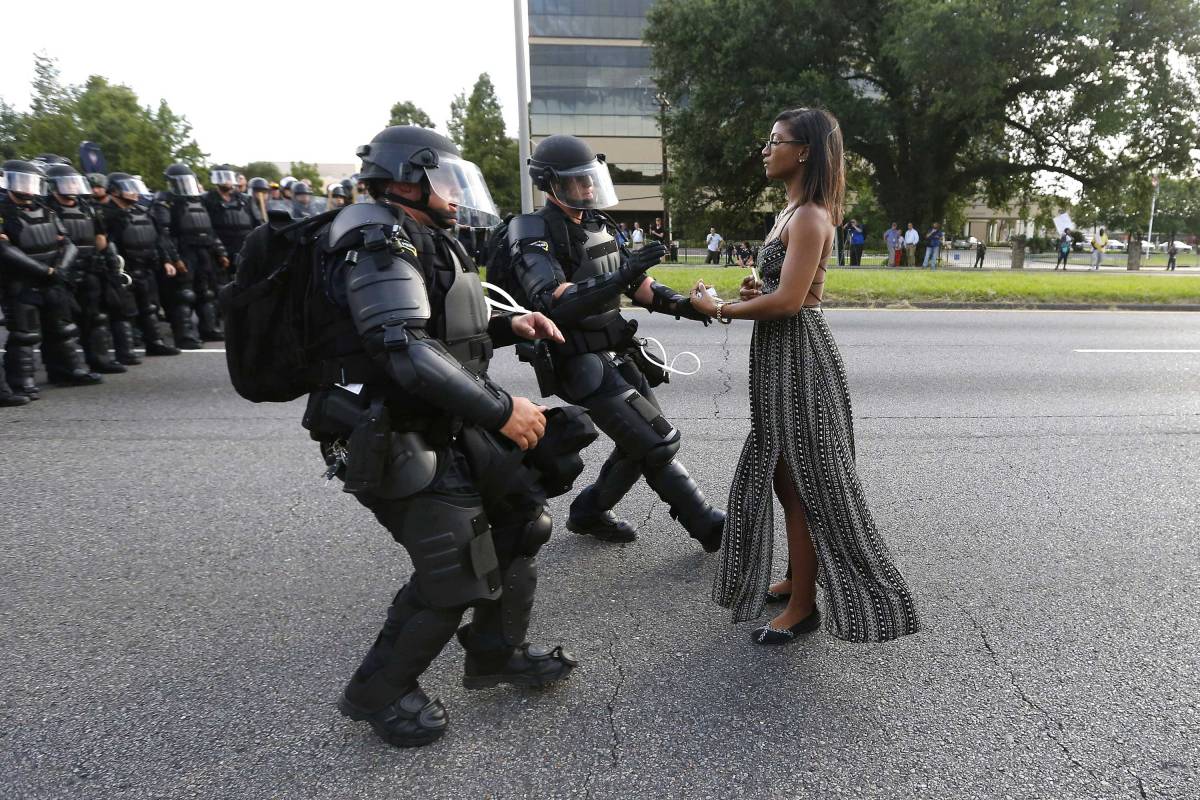
Ieshia evanS’ ARREST
by Jonathan Bachman
On July 9, 2016, a group of demonstrators protesting the shooting death of Alton Sterling by Baton Rouge police officers gathered on a road in front of the Baton Rouge police headquarters. A mix of Louisiana law enforcement officers clad in full riot gear responded, herding most of the demonstrators off of the road and into an adjacent park. I began photographing the face-to-face confrontations between the police and the demonstrators when I heard someone say something like “Don’t stand there.” I turned and looked over my right shoulder and saw this woman standing in the road. I knew right away what was about to happen. She was making her stand and the police were going to arrest her. I quickly moved closer and took the shot.
A few days later her name was released; Ieshia Evans, a 28-year-old nurse and the mother of a six-year-old son. Seeing her that day I thought of one word, “Powerful.” The strength and courage she displayed in standing up for a cause she so deeply believed in moved me.
Whatever the photographic merits of the image may be, I am most proud that it sparked an international conversation about police brutality and race relations in America. I believe that when there is conversation, no matter what side you are on, progress is being made and we begin to better understand one another. And to me, the ability to stimulate dialogue is one of the hallmarks of great photography.
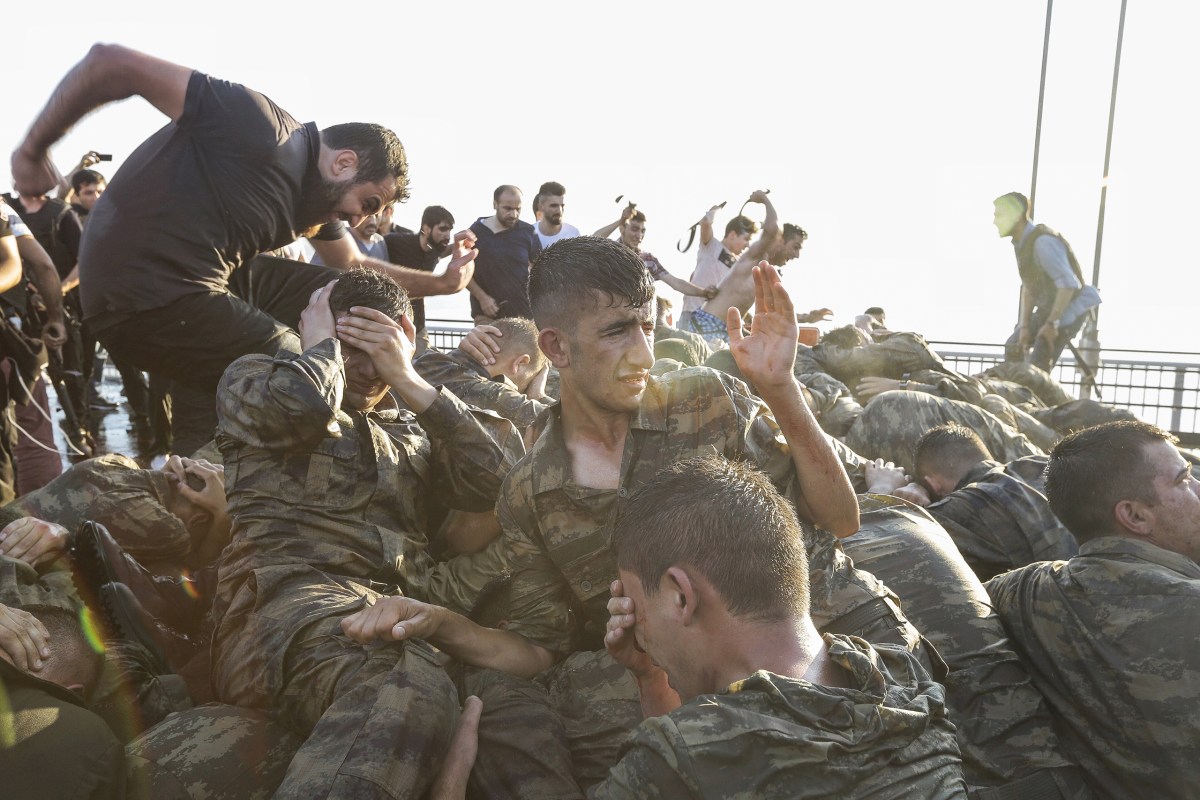
Turkey’s Coup
BY Stringer
The photographer, identified at the time of publication in July, declined an interview.
The Bosphorus Bridge in Istanbul connects Europe with Asia. In mid-July, scenes of chaos on this structure would bookend the failed coup. It was late on July 15 when Turkish soldiers appeared on the bridge and blocked traffic, igniting a storm of rumors on social media. Was there a threat from terrorists? Had an attack already been carried out? Neither.
Over the next nine hours, a faction within Turkey’s army would unravel a plan to topple the government of Recep Tayyip Erdogan, only to have it collapse within hours. The strongman they aimed to take down would emerge not only still in power, but more powerful than ever. In the early hours of July 16, soldiers involved in the coup surrendered on the very bridge that they and others had taken the night before. In a stunning scene on the roadway, still blocked to vehicle traffic, a group of soldiers in their army fatigues are seen as they’re beaten.
The image circulated widely in the days afterward, rising as a symbol of the clampdown that would ensue and of the people rising up against the army. It would even appear on the front page of The New York Times. The photographer has since asked for his credit to be removed from the picture, replaced with “Stringer,” but his name remains associated with the image and others he shot that day. Fallout from the coup has carried on through the year, predominantly in a purge of media (dozens have been shuttered) and the firings, suspensions or detentions of tens of thousands of police officers, teachers, soldiers, judges and more.
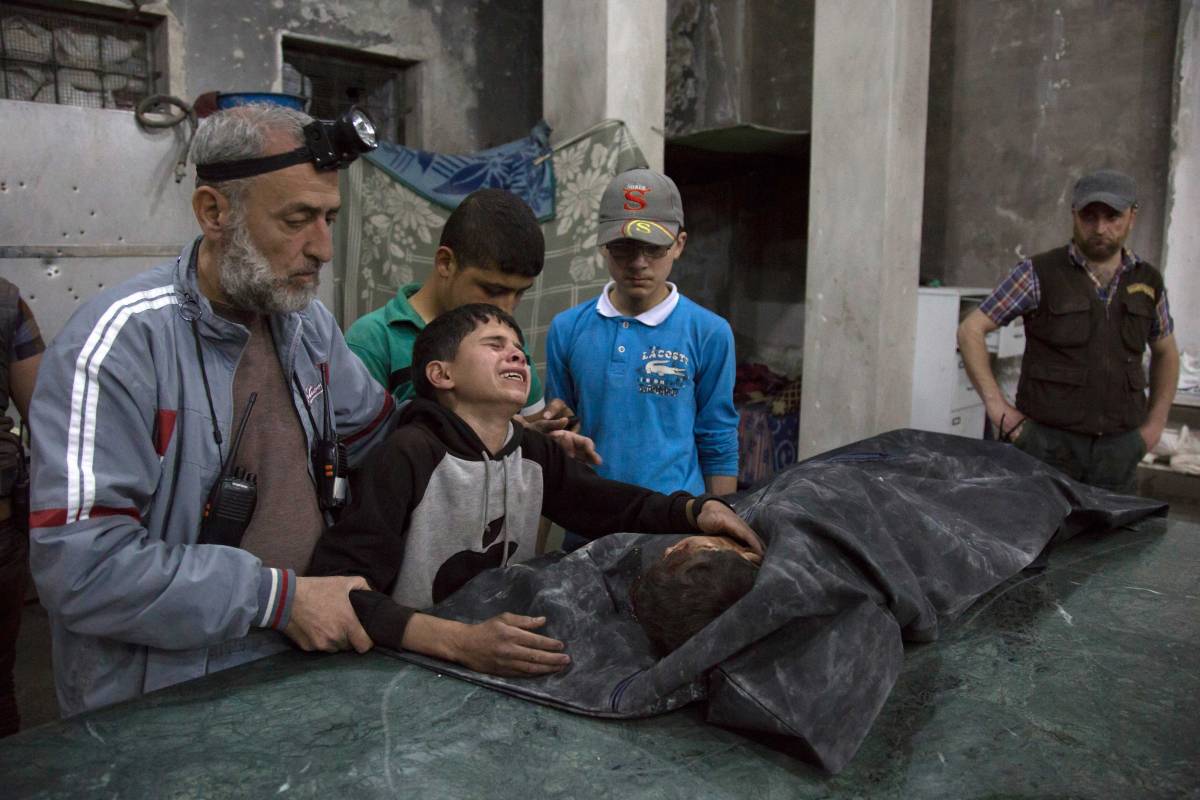
Syrian DESPAIR
BY Karam Al-masri
Seven months ago, I took this picture following Syrian government airstrikes on a hospital in the Sukkari neighborhood of east Aleppo. It was nine in the evening and I was at home when I heard the sound of a huge explosion. Fifteen minutes later, I headed to the area and saw that the hospital had been hit by several strikes, one hitting the hospital directly and the others the area behind it. I saw many dead people, some who had been walking past the hospital when the strikes hit, others who had been patients at the hospital or medical staff during their shift.
After I finished taking pictures of the hospital and the surrounding area, I decided to go to the medical clinic. Upon arriving I saw many bodies wrapped in plastic bags, some of them completely disfigured and others waiting to be identified. A couple of minutes later, this boy came into the clinic to look for his mother and little brother. He immediately recognized his brother’s body and burst into tears next to it.
He had lost a large number of his relatives. His father was killed not long ago as well. He was crying next to his brother’s body as some aid workers surrounded him trying to calm him down and console him. On that day that boy lost his mother too. Her body was in a big plastic bag under a table. Her face was completely deformed, disfigured, and he couldn’t recognize her in the beginning but was able to identify her later on through gold jewelry she was wearing.
The boy was crying and saying, ”I have no one left. Who will take care of me? Who will prepare food for me? Where will I live? Who will play with me?” At that moment the director of the clinic, Mohamed Kaheil, who is seen standing behind the boy comforting him, tried to calm him down, telling him, ”We are all your family members and siblings.”
When I started working as a photographer these scenes used to scare me and hurt me a lot. I remember the first time I took photos of people injured following an airstrike. I lost consciousness. I fainted after seeing people with cut-off limbs, and smelling blood and dead bodies. I have come up with a coping mechanism in order to deal with such harsh and cruel scenes. I no longer look at them with my eyes, I only look through the viewfinder while hiding behind my lens. I feel that my camera protects me as it creates a barrier between me and the reality of these scenes.
As for this specific image of the boy, it resonates a lot with me. I have a symbolic connection with this child, who reminds me of myself when I lost my family in shelling three years ago.
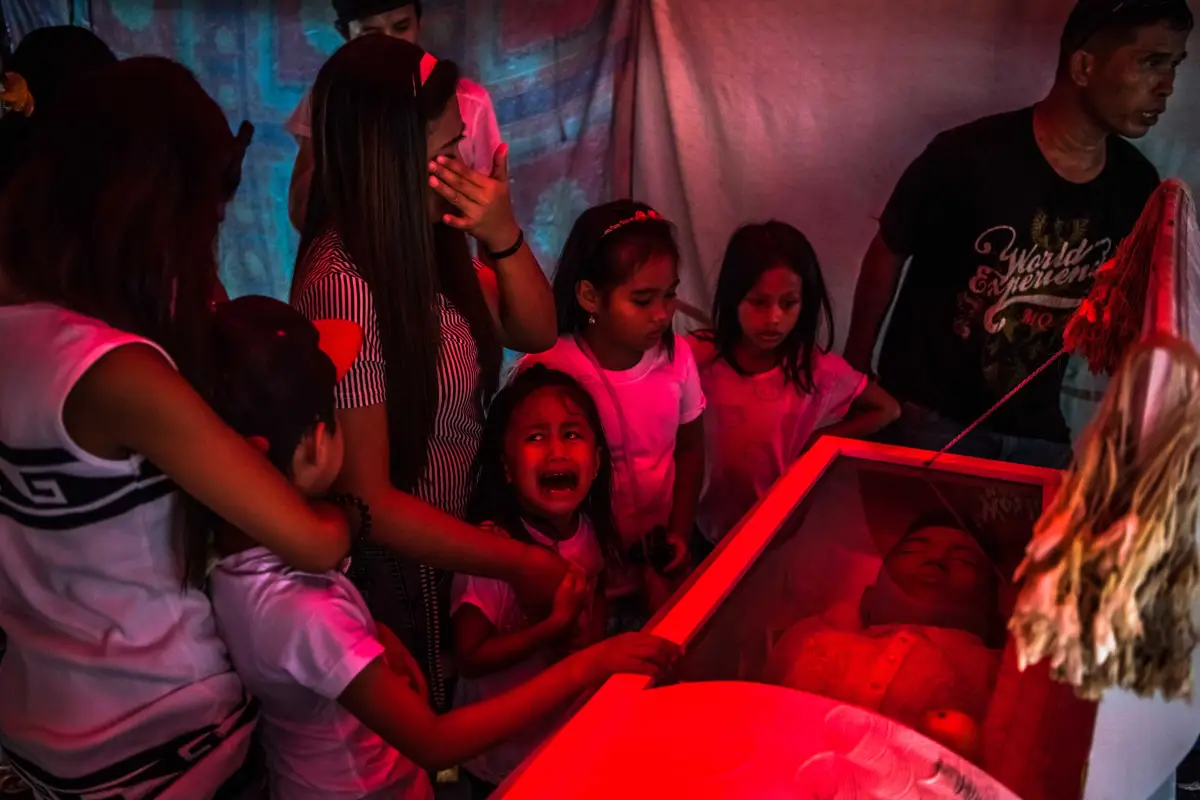
JIMBOY’s FUNERAL
BY Daniel Berehulak
This is Jimboy Bolasa’s funeral. It was on a Sunday, a week into a 35-day assignment in the Philippines photographing President Rodrigo Duterte’s brutal anti-drug campaign that have claimed thousands of lives.
There were two funerals that day. We’d followed up with the family of one victim. His body and that of a friend had been found under a bridge. As we made our way back, we decided to stop to the second funeral. When we arrived Bolasa’s family was about to start walking to the church and that’s when I heard the wailing and the piercing screaming coming from inside the wake. I followed the shrills in the tented area. Jimboy’s daughter, Jimji, was there and she didn’t want to leave the side of her father’s casket. She just kept on yelling, screaming: “Papa. Papa. Papa.” The coroners took his casket away and for close to half a kilometer, as they made their way to the church, a family member held Jimji. She kept on screaming until she was overcome, fatigued.
I have a sequence of four or five images that are very similar and whenever I look at that sequence, I struggle to get through it. It’s just the pain. It’s the sense of loss of all these childhood memories that you have with your loved ones, with your father. It’s crippling. It’s absolutely crippling to see that image and to see that little girl experiencing so much pain and loss; to know that her father was never given a trial, never had the opportunity to defend himself in front of a court. He was tortured and executed in the space of 30-45 minutes.
Through the actions and the words of one man, someone who as a leader people should be looking up to, this kind of acts are being condoned. Police and vigilantes are conducting these killings with impunity. There’s nothing these people can do. They’re completely helpless. That’s what gets me.
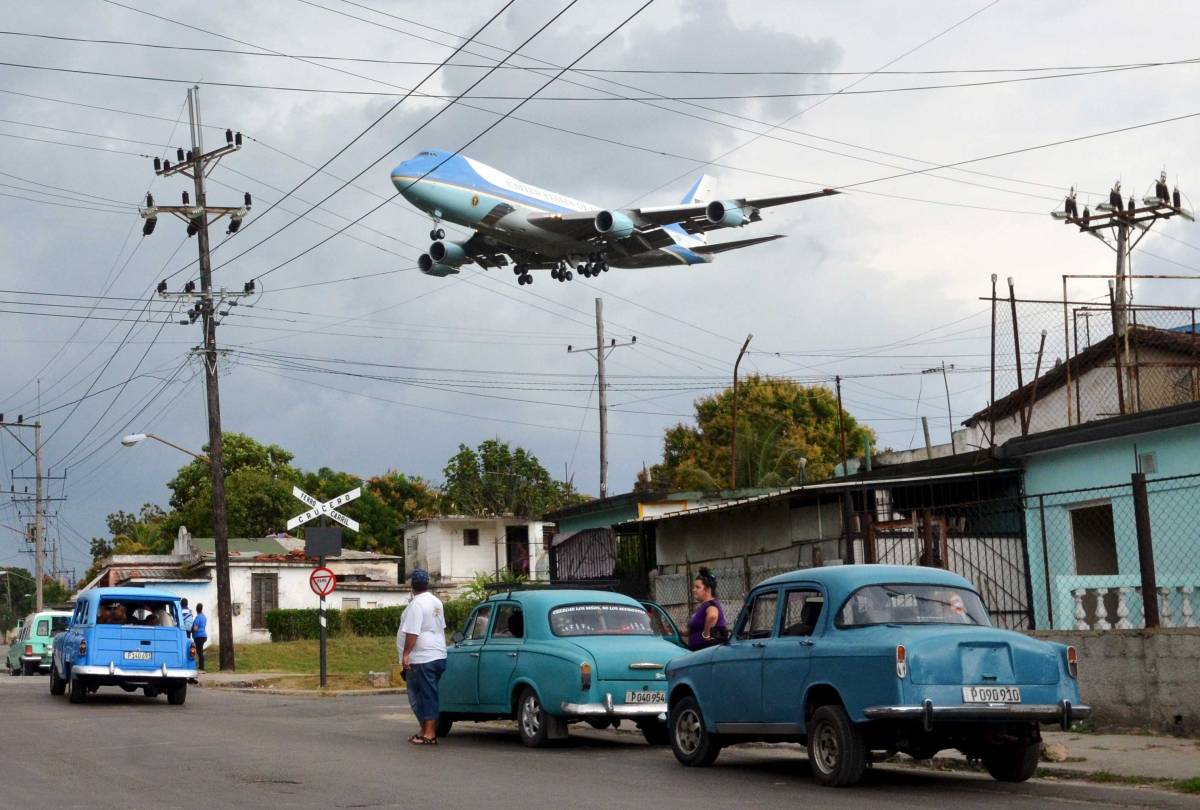
AIR FORCE ONE in CUBA
BY Alberto Reyes
We were a team of photographers getting ready to cover the arrival of U.S. President Barack Obama to Havana and we were planning how to illustrate his arrival before setting foot on Cuban soil. There was a lot of brainstorming and we decided to try to capture an image of Air Force One flying over Havana before landing at the airport. This being the president of the United States, he could probably fly in from any angle, so we split up looking for different positions around the airport with some visual detail that would explain that the plane of the U.S. president was about to land in Cuba. I wanted to go to a neighborhood near the airport, secluded from traffic and away from the security guarding the surroundings of the airport.
The office hired a motorcycle driver from the same neighborhood for me, I packed one camera with a short lens in my back pack and off we went. We arrived several hours early and just hung out discreetly. Suddenly I saw a plane, part of the advance team of the White House flying over and I realized that I was in the right spot. Next I heard the turbines and there it was, Air Force One. A few people were standing on the street, looking up into the sky as the massive plane, its colors matching the cars, approached the airport.
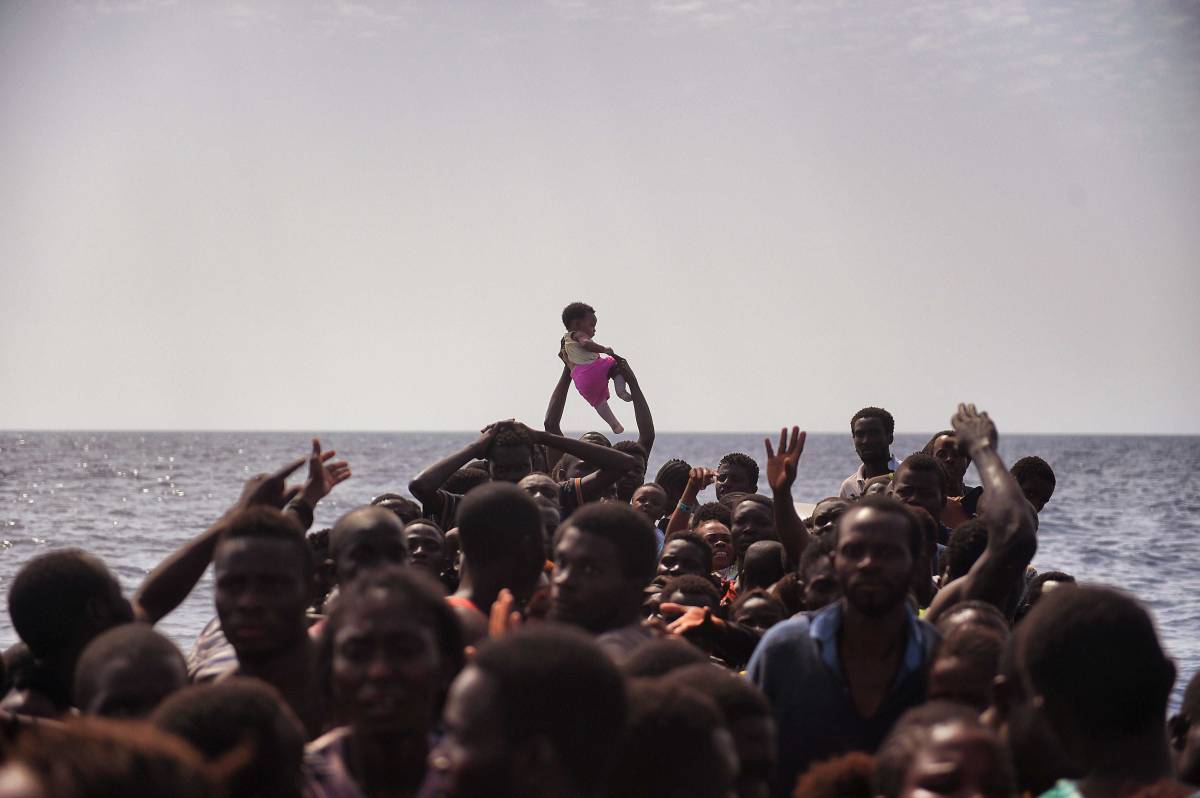
A RESCUE AT SEA
BY ARIS MESSINIS
I was embedded with a Spanish rescue team called Proactiva Open Arms and we were doing rescues in the Mediterranean Sea some 15 nautical miles off of Libya’s shore. The day was an extremely busy one because our team was completely alone in that area and we had to rescue more than 3,000 people. From the very early hours of the morning, we were finding the boats of refugees, delivering them life jackets so they would feel safer until the rescue operations got underway. Unfortunately, after delivering 2,500 life jackets, we ran out.
When we approached this boat, which had 220 people packed on board, they were all screaming for help. They told us that there were many dead people in the boat. Among the survivors, some had babies and they were holding them up so they would be rescued. One of these babies is in this picture.
When you capture this kind of images, where people are in danger and so desperate, it can be very hard. You have to hold back your emotions to report what is happening. After taking a few shots, I put down my camera and helped the rescue members bring the babies and their mothers to safety.
It’s sad that in the 21st century we’re still faced with a reality that brings us back to the age of slavery boats. But as long as this keeps happening, it’s very important that we’re there to record it so nobody can say that they didn’t know.
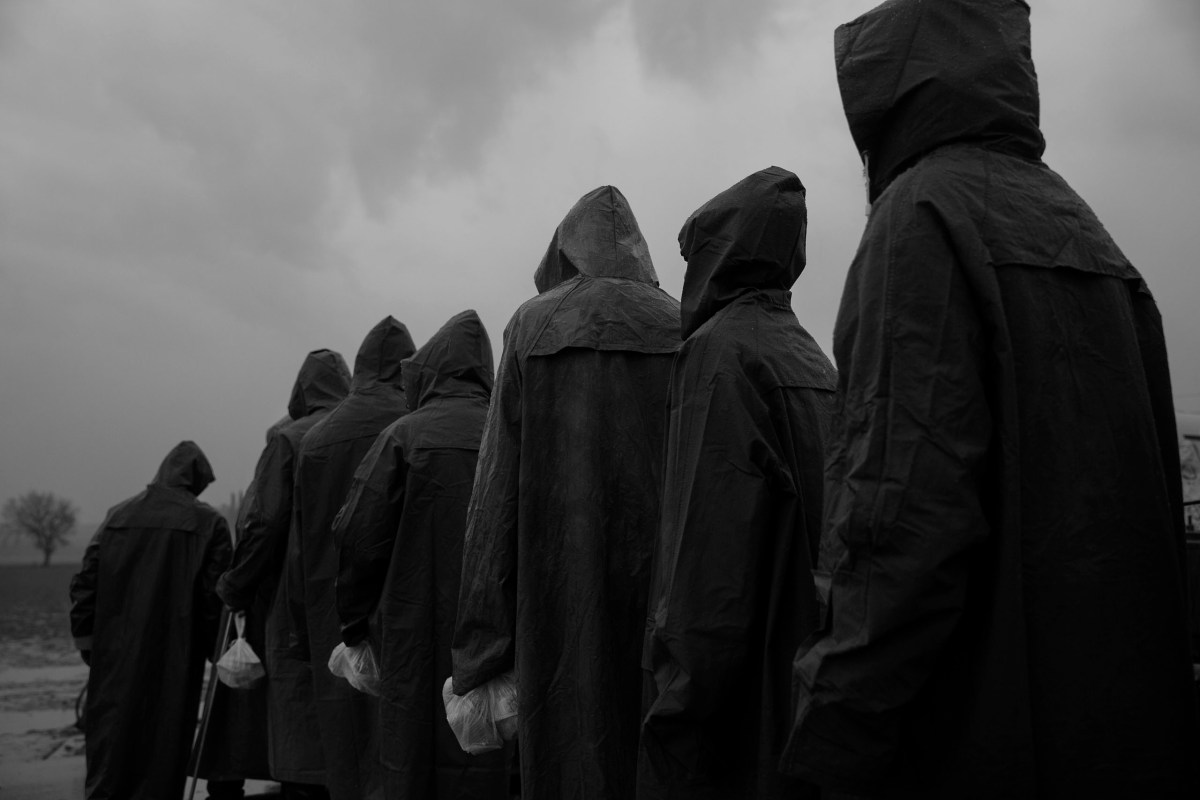
Refugees
BY JAMES NACHTWEY
Hundreds of thousands of people fleeing war; crossing the Aegean Sea from Turkey to Greece in a flotilla of frail rafts; trudging en masse across the countryside of Europe; living in huge, squalid encampments in the rain and the mud; facing ranks of armored troops protecting themselves behind shields, is a narrative out of the Middle Ages.
A group of refugees along the Greek-Macedonian border, waiting to receive a ration of hot tea on a cold, rainy afternoon created a visual time warp revealing how medieval the twenty-first century can be.
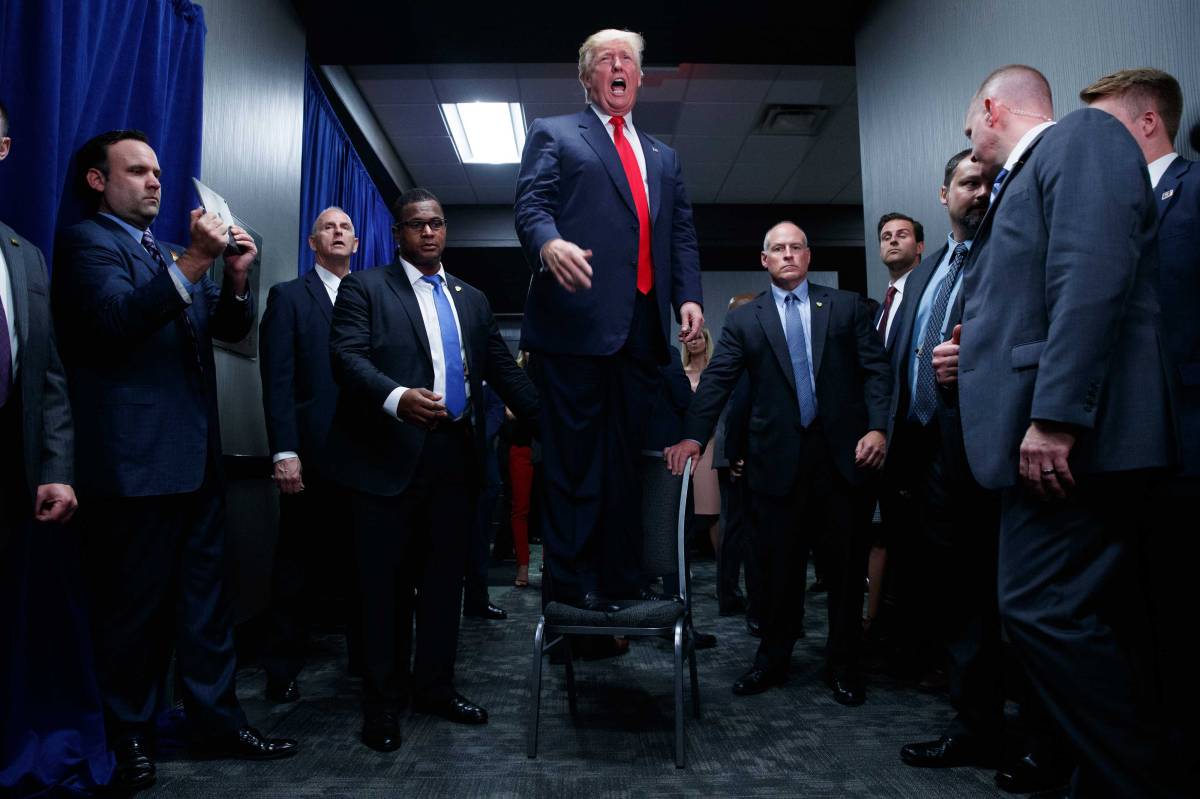
Donald Trump
BY Evan Vucci
I’d been on assignment for the Associated Press since the Republican National Convention covering Donald Trump. At this point in a campaign, the long days begin to run together and when you wake up in the morning it can be hard to remember if you’re in Iowa or Ohio. But I do remember something vividly about the day I took this photo: Trump was in an excellent mood.
As we were backstage with the candidate and making our way to the overflow room, he was all smiles and well wishes. I had never seen this side of him and I was actually embarrassed that I still knew so little about the man. Trump is almost a caricature to supporters and foes, and it’s extremely difficult to break through that façade over the course of a campaign. Every single moment is scripted by the candidate’s staff to put him in the best possible light. Our job is to try to break through that stagecraft to find the truth and accurately tell the story.
Trump was addressing an overflow crowd that was unable to get into the main room in Greenville, N.C. to hear him speak. I was fighting with Secret Service agents, staff and the crowd to get into position to photograph Trump speak. As I was getting into position, I saw Trump getting onto a chair. I couldn’t believe my eyes. This is the last thing I would have expected from the candidate and it turned out to be one of my favorite moments from a very difficult campaign.
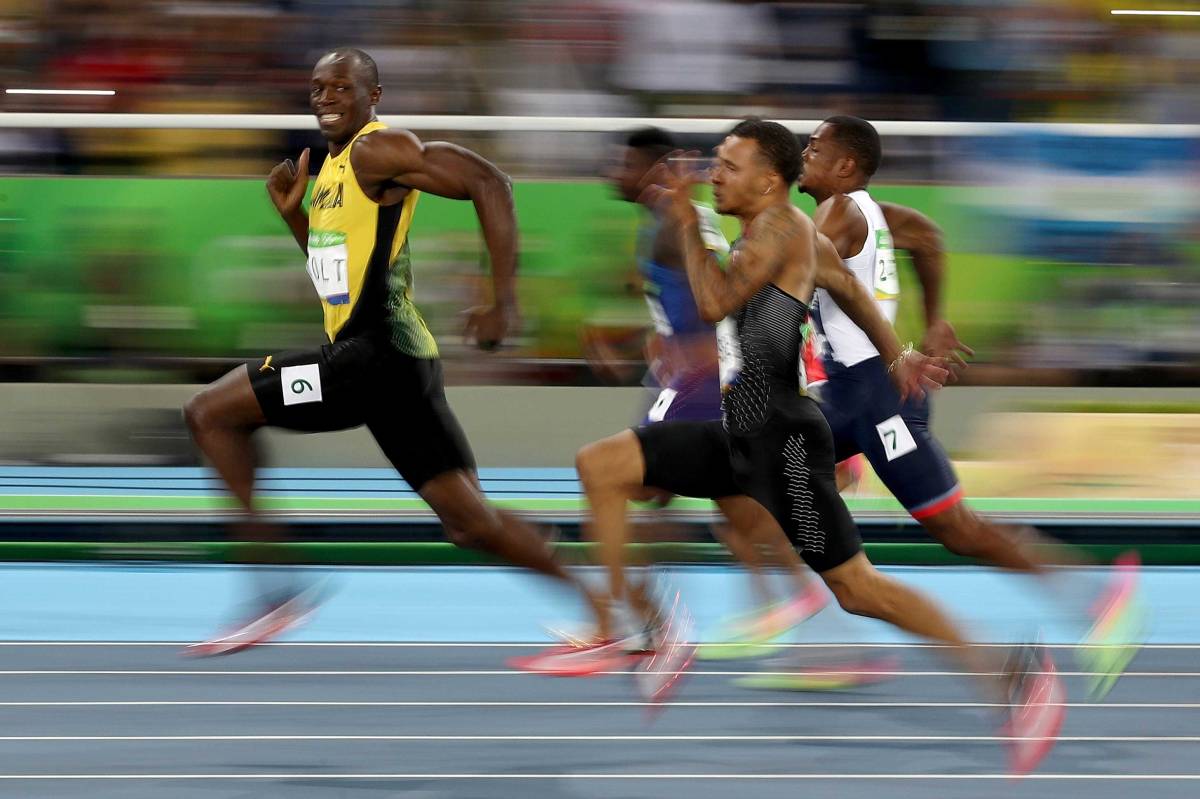
USAIN BOLT
BY Cameron Spencer
This image shows the world’s fastest man in history dominating the field in a semi-final at an Olympics. I was one of 11 photographers working for Getty Images assigned to the track and field that night. I was shooting from an infield position and decided to take a risk using a slow shutter speed, a technique known as panning. My aim was to show a lot of movement in the image to create a sense of speed. I chose to situate myself at the 70m mark confident that Usain Bolt would be out in front of his competitors by that point in the sprint. It wasn’t until I looked at the back of my camera after the race to check my images were sharp that I realized he appeared to be smiling in my direction. I believe at this point in the race he “turned off the gas,” slowing down and saving some energy for the final which was later that evening. Bolt made it look too easy in this blue-ribbon event and was glancing around at the other athletes behind him as he enjoyed the final seconds of the semi-final.
I feel very fortunate to have been able to photograph one of the greatest athletes of all time; witnessing Bolt’s career to date, photographing him running at the last three Olympic Games and at two World Championships. I like his expression in the image as it adds an element to the photograph, an unexpected defining moment. It sums up his personality, his showmanship, his confidence combined with his perfect running technique with his large stride.
Reflecting on the image, Bolt is an entertainer and feeds off the energy of the crowd on big occasions and always looks relaxed and like he is having fun. He enjoys himself out on the track, it’s his stage. Bolt’s success is a reward for the countless hours of hard work he puts in training for his chosen discipline. His style, ability and charisma makes him a perfect subject to photograph and it’s not only exciting documenting him making history, but a truly spine-tingling experience.
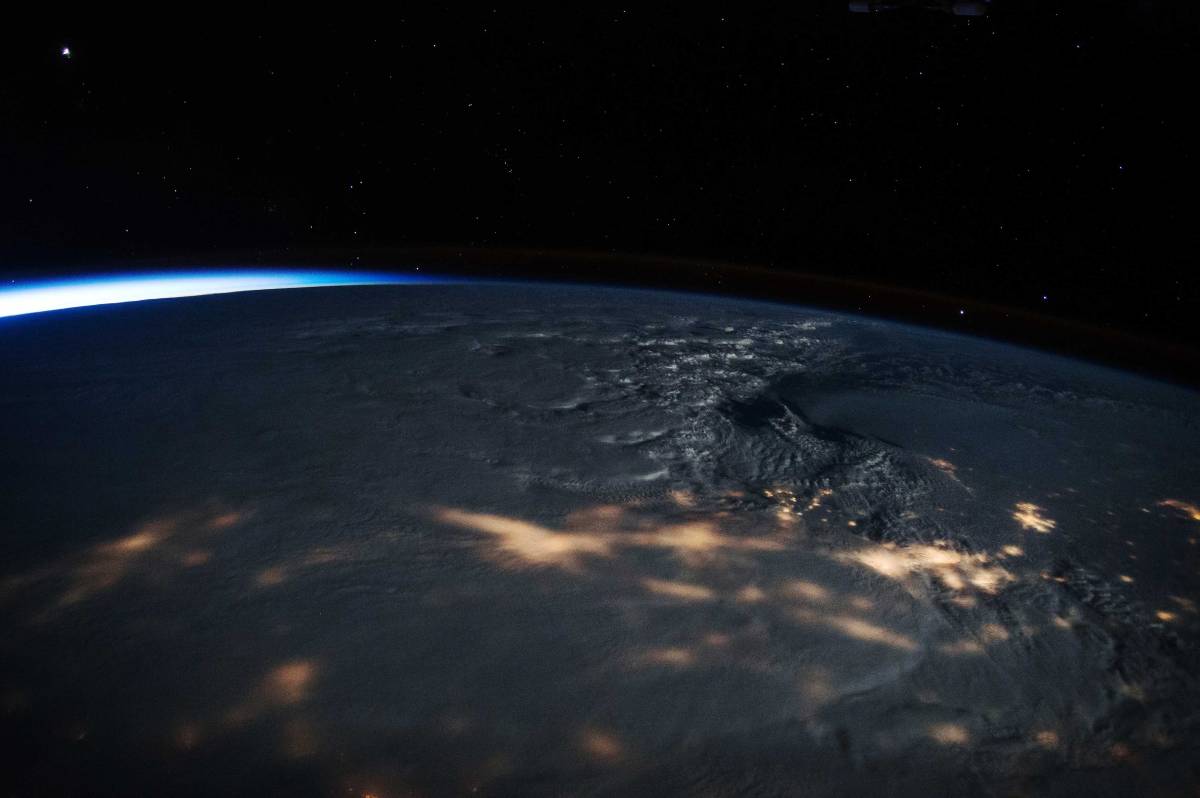
Snowstorm
BY Scott Kelly
When I was on the International Space Station, I’d follow weather events throughout the world. If it was something that was going to impact the U.S., I ‘d be more aware of it and I’d try to get a picture that would, in some way, give the magnitude of the storm to people in a way that they can relate to. My thought was that if I could get a good picture and show people how nasty this thing looked maybe they would take it more seriously and be more aware of it.
I knew about this particular snowstorm but I also knew the lighting conditions weren’t going to be right to get a picture because at that time we were passing over that part of the U.S. in the early morning darkness.
I have this philosophy that every time I thought I might not get a good picture, I’d just make sure to try because you never know what you might catch in camera. In this case, I went to the window and the timing and the lighting was just perfect. You could clearly make out what part of the U.S. that was. It’s also a good picture of the cloud with the right definition and depth of field on the image to see the magnitude and size of the storm.
And it’s also pretty awesome to see your picture on the evening news the next day.
Follow TIME LightBox on Facebook, Twitter and Instagram.
Produced by Olivier Laurent | Reporting by Olivier Laurent & Andrew Katz
